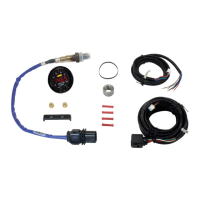8
7/12/2017 - DOCUMENT NUMBER: 10-0300
© 2017 AEM Performance Electronics
30-0300 X-Series UEGO Gauge
What is a UEGO Wideband Sensor?
A Universal Exhaust Gas Oxygen (UEGO) oxygen sensor, also known as a wideband or lambda sensor, measures the
proportion of oxygen (O2) in the exhaust of a running engine. An air to fuel ratio (AFR) or lambda value can be calculated
from this measurement. Typically, when calibrating or "tuning" the fuel delivery system of an engine, a specific AFR can
be targeted to achieve maximum power, economy, or emissions. The output from a UEGO sensor controller can be used
to adjust a carburetor or fuel injection system to reach this target.
UEGO sensors are one of the more sophisticated sensors found in today's vehicles. The sensing element is made of a
zirconium dioxide ceramic with a thin platinum coating and has an integrated heating element. An electronic controller,
such as is contained in AEM's X-Series UEGO Gauge or Inline Controller, is required to use a UEGO oxygen sensor.
The controller connects to the sensor via multiple wires (up to 6) carrying sensitive voltages and electrical currents to
process and calculate an AFR value. This value may be read directly from a gauge face or data-log as recorded by an
ECU or logger via several methods as discussed elsewhere in this manual.
Interpreting Wideband Sensor Readings
An internal combustion engine runs on air (which contains
~20% oxygen) and fuel. The ratio of air to fuel (AFR) that,
when combusted, perfectly consumes 100% of both the
oxygen and fuel is called the stoichiometric ratio. This ratio
is different for every fuel. Ratios lower than stoichiometric
have more fuel and are considered "rich"; ratios higher than
stoichiometric have less fuel and are considered "lean."
Lambda is a unitless ratio that is fuel agnostic. In other words, a lambda reading of 1.0 is stochiometric for any fuel; AFR
= ( Stoichiometric AFR * Lambda.)
In general, an engine will have three areas of operation: idle/cruise, wide open throttle, and fuel cut off. The exact AFR
value that should be expected (or tuned to) for these areas is very specific to the type and configuration of each individual
engine. However, while monitoring your AEM X-Series controller, you should see readings similar to the chart below. Fuel
cutoff is generally experienced when completely lifting off the throttle, while decelerating in gear, at high RPM.
IMPORTANT NOTE: Engine tuning should only be performed by experienced individuals as engine damage, or outright
failure, can be the result of an improper calibration.
Sensor Placement
The location at which the sensor is installed in the vehicle's exhaust system is critical to its performance and longevity.
Please review the following placement guidelines:
o 18 inches (45cm) downstream of the cylinder head's exhaust port or turbocharger
o Upstream of any catalytic converters or emission control devices
o Downstream of any turbochargers or large contributors to exhaust pressure
o As far as possible from the exhaust exit (tailpipe) to avoid scavenging fresh air in low exhaust flow
conditions such as idling
o AEM's X-Series UEGO controller is a very sensitive device and, thus, it is important to have a
completely leak-free exhaust
Sensor Bung
The supplied mild steel sensor bung must be welded into the vehicle's exhaust. An optional stainless steel sensor bung
is available for purchase from AEM dealers and may be useful in specific installation scenarios. The taller geometry of
this bung helps bring the sensing element further out of the exhaust stream when used in small diameter tubing such as
header primaries. In addition, the finned body helps dissipate heat when used in extreme applications. As an alternative
to welding, users may purchase a P/N 30-2355-XXX No Weld UEGO Clamp Kit.

